Castel Sant’Angelo Rome | Exclusive Museum and Mausoleum of Hadrian Official Private Guided Tours
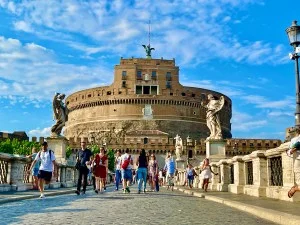
Castel Sant’Angelo Rome (Castle of the Holy Angel) – Mausoleum of Hadrian, built by Emperor Hadrian (130-135) after his return from his many travels all over the Roman Empire and probably inspired by the famous tomb which Queen Artemisia had erected in honor of her husband “Mausolo” the King of Caria, which Hadrian had seen in the course of his travels.
The tomb and bridge were built according to the design of the architect Detrianus; some archaeologists suppose that a bronze canopy once surmounted the bridge. No less than twenty-one members of the Imperial family of the Antonines were buried in this mausoleum, which was abandoned after Septimius Severus’s death.
When Emperor Aurelian built his walls in 270, the tomb was one of the many buildings embodied in the city’s fortification system. Still, it was only at the time of Honorius (423) that it was converted into a fortress for the first time.
Tomb of emperors, fortress, the residence of King’s princes and popes, political tribunal, place of execution of popes, cardinals, and eminent personages, and lately barracks and museum, it resumes and contains the history of pagan, Christian, and modern Rome of about eighteen centuries.
The present name of St. Angel’s Castle in Rome derives from a church tradition that narrates that in 590, while Pope Gregory the Great was leading a penitential procession to the Church of St. Peter to stay the plague, he had, when on the bridge, the vision of St. Michael the Archangel, on the summit of the castle, showing a bloody sword as a promise of the cessation of the plague. The tradition adds that after the apparition, the plague stopped as if by enchantment. To commemorate this event, the statue of St. Michael was erected on the top of the castle, hence his name. The tenth century, the most turbulent period of the Middle Ages, is perhaps the most important in the political and military history of the castle when Theodora, Marozia, and Alberico lived in it and during which twenty-four popes succeeded each other on the throne of St. Peter, several of whom died of violent death in the castle. Official Rome Guide, (Castel Sant’Angelo Rome) Rome walking City Tours
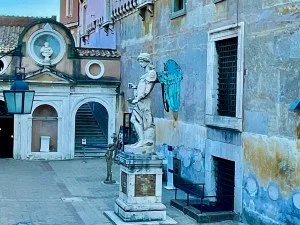
Nicholas III, in 1277, is said to be the first pope who removed the papal residence from the Lateran to the Vatican because of its vicinity to the castle. From this period, it was held by the popes, who constructed the fortified passage uniting the papal residence with the fortress, where the popes could find a safe place of refuge in case of danger. (Castel Sant’Angelo Rome) Since then, it has been, for many centuries, the most important fortress in the city, kept by the most powerful party of Rome, as its possession signified the town’s possession. The oldest writer who described the tomb is Procopius, who saw it in the 6th century when the mausoleum was still partly covered up with blocks of Parian marble, closely fitted together without any mortar, its basement being square with four equal sides, a stone’s through the length. The top part was ornamented with precious marble, bas-reliefs, and Greek and Roman statues collected by the Emperor in his travel all over the Roman World; in the four corners were groups of men and horses in gilt bronze. (Castel Sant’Angelo Rome)
Among the ornaments were inscriptions in honor of the different members of the Imperial family buried in it. The whole building was surrounded by a rich bronze railing surmounted by peacocks, one of which is now preserved in the Vatican. In the 12th century, the English Pope Hadrian IV caused Arnoldo Da Brescia to be imprisoned here before he was burnt alive; Benvenuto Cellini also imprisoned her under the accusation of having stolen some of the gems of the pope’s tiara, but in reality, on account of the hatred the pope and his nephew had for him.
It isn’t easy to describe the castle’s historical alterations, which would require a large volume, so we can only spare a little space for its history and description of its interior. (Castel Sant’Angelo Rome) | Official Rome Guide, Rome walking city Tours.
Inside Castle St. Angel, as soon as we enter, we find ourselves in the “ambulacrum,” or passage excavated in the 13th century by order of Pope Boniface IX, in the base of the tomb, which runs all around the tower. On the left, down below, we see the sepulchral cellars, where different members of the Imperial family of the Antonines were buried. In the Middle Ages, these chambers were used as state prisons, stores, etc., as testified by the existing remains. Further to the left, we find a little museum containing fragments of the original ornaments of the tomb, a part of the frieze that surrounded the top of the mausoleum, bricks with brick marks of the period, and a model of the tomb, according to the reconstruction of Prof. Borgatti, which gives an excellent idea of the original form of the mausoleum—guide of Rome.
Retracing our steps, we reach the “tourniquet,” through which we enter the castle; turning to the left, we see the original Roman entrance to the Mausoleum, once lined with marble and ornamented with a mosaic floor ì. At the end of the niche is a niche originally containing the statue of Emperor Hadrian.
Proceeding to the right, we pass through the original Roman spiral ascent, which describes a complete circle and leads to the emperor’s sepulchral cellar.
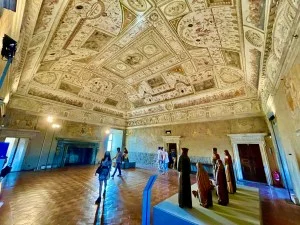
Four pyramidal-shaped openings or air shafts, at equal distances from each other, provided light and ventilation to the corridor; these openings were also converted in the Middle Ages into horrible jails, with prisoners lowered down from the top.
At the end of this corridor, we pass through the lift from Pope Clement XII’s time, leading up to the papal apartments; the large wooden beans, with groves to guide the lift up and down, are still in situ.
Here, we see another passage that pierces the tomb diametrically from north to south and crosses the sepulchral chamber. This consists of a square room about 27 feet wide, with recesses where the coffins of Hadrian, his wife Sabina, and Antoninus Pius are said to have stood. These recesses were initially surmounted by rich canopies (as is shown by deep cutting in the walls), and the room was decorated with ornaments in bronze and gold. The floor was of Parian marble, traces of which are still visible. The baptismal font in the church of St. Peter is believed to be the lid of the coffin in which the remains of the emperor Hadrian rested.
A modern bridge crosses the tomb, preventing inspection of the sepulchral chamber. This is the only part of the mausoleum that, although deprived of its original decoration, has been handed down to us to give an idea of the grandeur of the Roman construction, built out of large blocks of travertine. The walls were decorated with the best marble, as shown by the holes that served to fix the marble slabs.
The cellar is closed by a vast and robust wooden door with an opening large enough to allow a person to pass through. On each side are two pyramidal openings (pierced through the thickness of the walls) where cannons could be fired, forming thus a very efficacious defense to the fortress. Proceeding through the passage, at the end of it, we turn to the left, where we see a door giving access to a horrible prison receiving air and light through a small opening; this is said to be the prison of Joseph Balsamo (Giuseppe Balsamo) the famous Count Cagliostro. According to others, this was a temporary prison for newly arrived criminals and political offenders destined to the castle or had to be tried by the tribunal, which administrated justice in the castle.
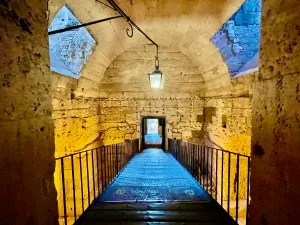
A little further, the Court of the Balls entered the next. This is called so from the catapult balls we see heaped around. Opposite the entrance is the little facade of the chapel of St. Michael the Archangel, which we will enter from the hall of Pope Paul III. The facade attributed to Michelangelo, who designed it for Pope Leo X, is decorated with two little niches recalling the Medicean Tomb of Florence. On the left is visible the old angel, which once surmounted the mausoleum and was replaced in 1753 by one by Peter Vershaffelt, visible now on the top. The angel is attributed to Raphael da Montelupo.
In the first room, on the right of the entrance to the courtyard, we see the bodyguard for the defense of the passage and of the superior part of the fortress; in the following three rooms, there is an armory showing the development of the weapons from prehistoric times down to the 19th century.
The first door on the left gives admission to the Hall of Pope Clement VIII; this is a little museum of the fortress and contains many inscriptions and coats of arms of different popes and an interesting chimneypiece, which stood once at the entrance of the castle, now demolished. In the center of this room are four reconstructions by Prof. Borgatti of the Castle as it was in various periods.
Fixed on the walls, visitors will notice a great many coats-of-arms of different popes entirely obliterated;
This work of destruction is due to the soldiers of the French Republic, who saw in the popes the greatest enemy of their form of government.
In the hall on the left, we see engravings and designs representing the Castle in its different periods.
Retracting the steps we pass, opposite the Hall of Justice occupies the very center of the building, above Hadrian’s tomb, which we have already seen. The hall is so-called because it was used as a tribunal at the time of Pope Julius II and Paul III. Now, it is transformed into a small armory, where a collection of different weapons is preserved, including bombards, spears, swords, etc. All are found in and around the castle.
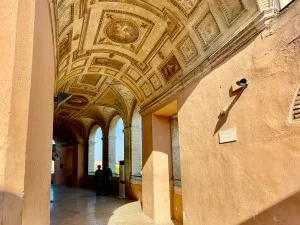
Next, we enter the Hall of Apollo, a large hall named for the ceiling decoration illustrating the myth of Apollo attributed to Giovanni da Udine and Perin del Vaga. In the center of the ceiling is the coat of arms of Pope Paul the III Farnese, which we can also see in the chimneypiece at the end of the hall. Official Rome Guide, Rome walking city Tours.
On the right is the Chapel of St. Michael the Archangel, the facade on the courtyard outside.
The chapel is a reconstruction and modification of an earlier one, which is supposed to have been built by Pope Benedict IV in about 900 and rebuilt by Benedict IX (1033.1044); the present one dates probably from this period but underwent some modifications in the 16th century and was altered to its present state by Pius VII.
Leaving the hall from the door opposite the chapel, we reach the:
The apartment of Pope Clement VII consisted of two rooms: this was occupied by this pope during the sack of the Bourbons in 1527.
Turning to the right, we enter the Courtyard of Alexander VI or the theater called so from the fact that this courtyard was used as a theater in the time of Clement X. On the left is a very beautiful and exciting “puteal,” or mouth of a well, from the time of Pope Alexander VI, whose coat of arms is still in a good state of preservation; it served to draw up the water from the cistern below. The “puteal” owes its preservation to its having been, until a few years ago, concealed and embodied in later construction, recently demolished.
On the right entrance: The Bathroom of Pope Clement VII, ornamented with interesting frescoes and stucco by Giulio Romano, the pupil of Raphael, has a heating apparatus on the system of the baths of Pompeii.
Returning to the courtyard, we see a door on the right leading down to the: Turning to the right, we enter the Courtyard of Alexander VI or the theater called so from the fact that this courtyard was used as a theater in the time of Clement X. On the left is a very beautiful and exciting “puteal,” or mouth of a well, from the time of Pope Alexander VI, whose coat of arms is still in a good state of preservation; it served to draw up the water from the cistern below. The “puteal” owes its preservation to its having been, until a few years ago, concealed and embodied in later construction, recently demolished. (Castel Sant’Angelo Rome)
On the right entrance: The Bathroom of Pope Clement VII, ornamented with interesting frescoes and stucco by Giulio Romano, the pupil of Raphael, has a heating apparatus on the system of the baths of Pompeii.
Returning to the courtyard, we see a door on the right leading down to the:

Turning to the right, we enter the Courtyard of Alexander VI or the theater called so from the fact that this courtyard was used as a theater in the time of Clement X. On the left is a very beautiful and exciting “puteal,” or mouth of a well, from the time of Pope Alexander VI, whose coat of arms is still in a good state of preservation; it served to draw up the water from the cistern below. The “puteal” owes its preservation to its having been, until a few years ago, concealed and embodied in later construction, recently demolished.
(Castel Sant’Angelo Rome) On the right entrance: The Bat room of Pope Clement VII, ornamented with interesting frescoes and stucco by Giulio Romano, the pupil of Raphael, has a heating apparatus on the system of the baths of Pompeii.
Returning to the courtyard, we see a door on the right leading down to the:
The last prison, at the end of the corridor, is said to be the very one where Giordano Bruno was confined before he was burnt alive in “Campo Dei Fiori.”
The next one is pointed out as the prison of Cardinal Caraffa and Lucrezia Petroni, and the next is that of Beatrice Cenci. These two ladies were undoubtedly confined in the Castle for some time before they were transferred to the other prison of Corte Savella.
Among those who died here was Fra Benedetto da Trojano, an ardent follower of Savonarola and his doctrines, buried alive in these dungeons and condemned to die of starvation by order of Pope Clement VII.
Before you go out, you can pass through the following: Oil stores consisting of a large room with eighty-four large jars of oil, which, more than for feeding the garrison, was used in case of attack for pouring it down boiling on the heads of the besiegers. Around are visible. Also, the silos were later on converted into prisons. In the openings that we see under some of the jails, bones have been found, leading antiquaries to believe that sometimes prisoners were buried, after their execution, under the cells where they had been confined—guide of Rome. (Castel Sant’Angelo Rome)
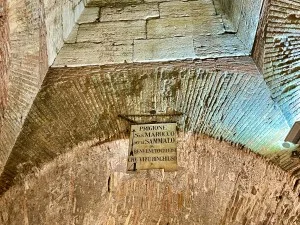
Another tradition points out one of these dungeons as the prison of Benvenuto Cellini, where he is said to have designed a Christ in charcoal, which is under glass, but to be frank, this design needs to be distinguishable. The great sculptor was undoubtedly imprisoned in the castle, and from here, he escaped, lowering himself down with a rope made with strips of the sheet. A staircase on the right leads from the courtyard to the:
The covered Gallery runs all around the upper part of the building. In this gallery are still visible some little rooms (containing now a collection of coins) which were still used as prisons for soldiers up to a few years ago.
Facing the bridge is the Loggia of Pope Julius II, which offers a fine view over the Tiber and the Southern part of the city. Bramante most likely designed the loggia, combining beauty, elegance, and simplicity. Official Rome Guide, Rome walking city Tours.
A few steps lead up to them: Pauline Hall, the most beautiful room in the castle, was built in the time of Pope Paul III and was richly decorated with pictures by the pupils of Raphael under the direction of Perin del Vaga. The hall was used as a place of assembly for papal meetings, consistory, tribunal, etc.; it was the scene of the famous trial of Beatrice Cenci.
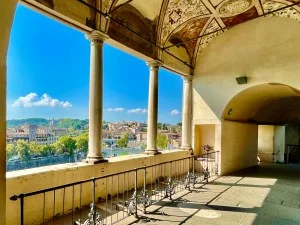
The figure of a man dressed in black on the painted door on the right of the entrance is the lawyer who defended Beatrice Cenci and other family members.
Paul III’s apartment is ornamented with pictures by Pierin Del Vaga representing mythological subjects, and the pope’s bedroom contains several pieces of family members.
The apartment of Paul III is ornamented with pictures by Pierin Del Vaga representing mythological subjects; the pope’s bedroom contains pieces of early furniture from the 16th century.
Library: a large hall used by the popes for such purpose until Paul III had all the books removed to the Vatican; the library is ornamented with grotesque frescoes reproducing mythological fables by Sicciolante, Luzzi, and Rapahel da Montelupo, who also designed the beautiful chimney.
A door on the right admits to the. Guide of Rome
The Treasury, or secret archive of the popes, has been preserved in the castle since Pope Julius II’s time. In the center of the room are three strongboxes (from Julius II’s time) where the papal state’s treasury was kept, together with precious church utensils such as chalices, monstrances, etc.
Terrace (Castel Sant’Angelo Rome) | From the terrace, one can enjoy a beautiful panorama, with St. Peter’s and the Vatican on the right, the passage of the popes uniting the papal residence with the castle, Monte Mario, the monument of King Victor II, the Pantheon, etc. Above us rises the statue of St. Michael the Archangel, sheathing his sword, by Peter Vershaffelt, erected there by Benedict XIV. Near the angel is the “Bell of Mercy,” called so because it was only rung when executions took place in the Castle to warn the poor wretches, who had been condemned, that their last hour had come.
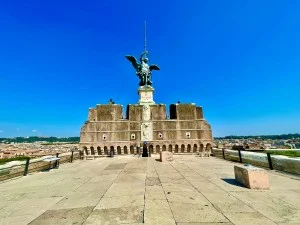
The large street leading to St Peter’s Basilica is named Via Della Cociliazione. Reconciliation Street is so-called from the agreement signed on February 11th
1929 between the Italian Government and Pope Pius XI. This street was formed, pulling down the “Borghi,” two narrow streets and a long line of old buildings, which prevented the complete view of the square and church of St. Peter.
Along this street on the right: The Palazzo Giraud, built by Bramante for the Card. Adriano da Corneto is a reception of the Palace of the Cancelleria, built in the same architectural style. Before the Reformation, it was the residence of the English ambassador to the Pope and now belongs to Prince Torlonia.
Castel Sant’Angelo Rome in Rome highlights the Vatican City and Vatican Museums. Special offers to organize official private guided tours for individuals, large or small groups. A selection of the best tours of Rome and the Vatican includes skip-the-line tickets and exclusive entrances to Rome’s most important museums and art galleries. Please do not hesitate to contact us to book your tour or holiday in Rome.




